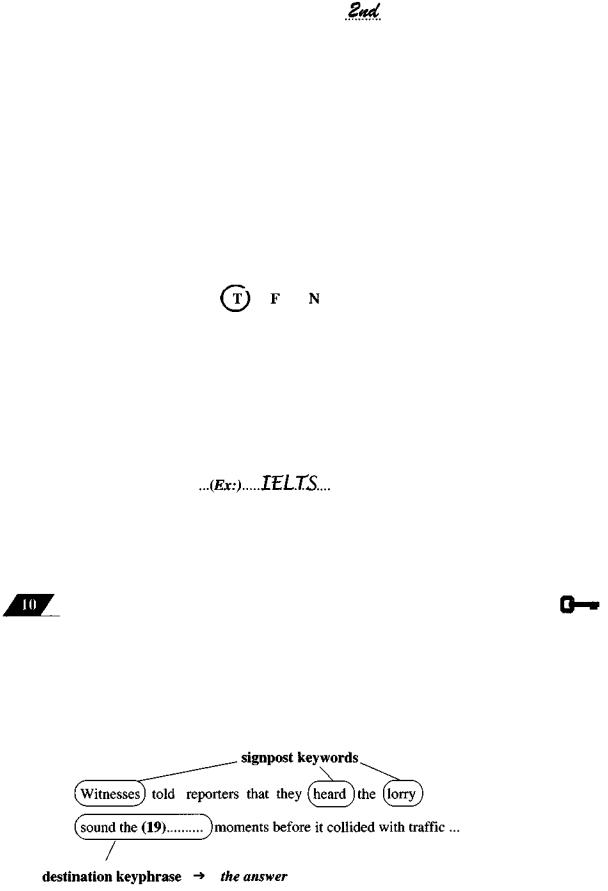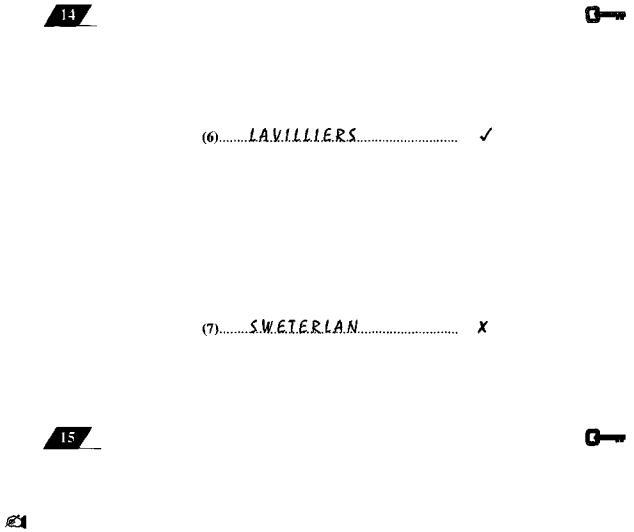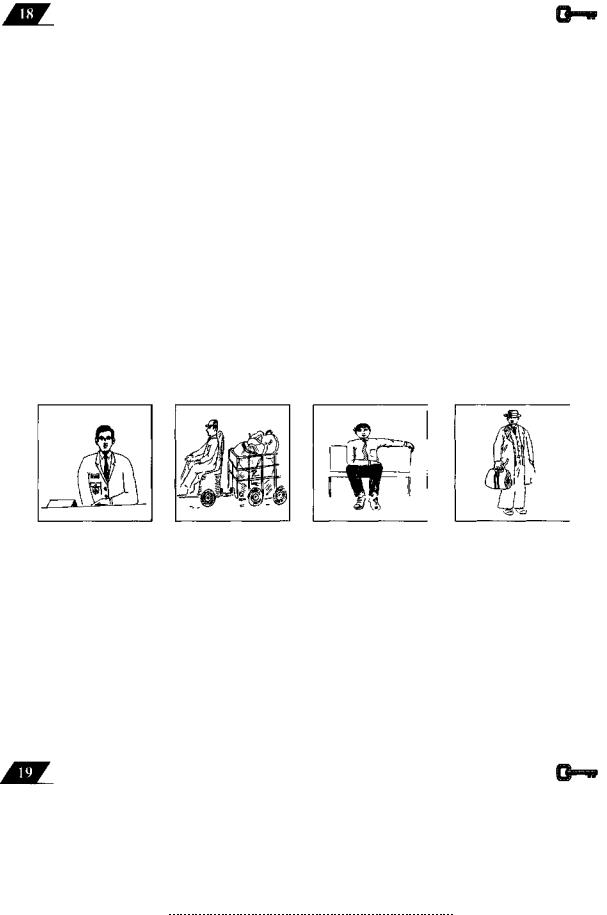
Helpful_Hints_for_IELTS
.pdf
IELTS Test - Basic Hints
INCREASE YOUR PERSONAL SPEED
In the IELTS test, time is your enemy. Candidates who have taken the test and did not perform as well as they had hoped often complain that they were unable to give all the answers in the Listening Test because the tape was too fast, and that they ran out of time in the Reading Test.
To begin with, do not worry if you do not finish the tests. Remember, the test is designed to measure candidates over a range of scores from 0 to 9 (0 indicates the test was not attempted). Candidates whose English is near perfect can expect to score 9, but even native English-speaking people would be unlikely to complete every Listening Test answer perfectly or finish the Reading Test a long time before the examination ends. Remember, the test is meant to be challenging.
The IELTS test measures many aspects of your English ability including the speed at which you listen, read, write, speak, and think in English. Your personal speed is not something which changes a great deal from day to day, but does change considerably over a longer period of time, as a direct result of practice in working with the English language.
Your personal speed and ability in the 5 areas previously mentioned is pretty well fixed at any given time. The official IELTS Band Scores you receive are extremely accurate, since each test is trialled extensively to achieve standardised results for candidates at all English levels. Nonetheless, there are certainly many things you can do, before and on the day of the test, to help maximise the use of your time and give yourself the best chance of success.
Consider the following situation: although a racing car cannot go faster than its maximum speed, the race can still be won, and its maximum speed maintained forlonger, ifan expert driver is at the wheel. An expert racing car driver will:
(before the race) |
... spend a great deal of time practising at the wheel before race day |
|
... visit the track so that he or she knows where to go and what to expect |
|
... get enough sleep before the day of the big race |
|
... eat a good breakfast on race day morning; |
(during the race) |
... check his or her watch constantly to monitor the car's progress |
|
... keep moving along the track and not get stuck on a bad corner |
|
... breathe long and deeply to relax and keep the oxygen going to the brain |
|
... drink water (but not too much!) when the car is at the pit-stop. |
The Listening, Reading, and Writing Tests are given in that order, and are usually held on a single morning. The combined length of those three tests is 2 hours and 30 minutes. (The Speaking Test is conducted at an appointed time in the afternoon.) Only one short break is given between the Reading and Writing Tests, so you need to be at your best for a long period of time, which is why you must sleep and eat well before the test. The hints and guidelines in this book should help you achieve your "maximum speed". The more effort you put in, the faster your personal speed will be on the day. (See also IELTS Test - Basic Hints 1 and 2.)
INCREASE YOUR SENTENCE READING SPEED
The faster and more accurately you read, the more questions you will be able to answer. In all the tests, the instructions, the example, and the questions themselves need to be read quickly, and must be well understood in order for you to have more time to find the answers. It pays to increase your overall reading speed. (See also Reading Hint 41.)
To increase your reading speed, you must learn to read in groups of words that form logical units of thought within sentences. Look at the following sentence:
Britain has been a popular choice for thousands of international students over many years.
13

101 Helpful Hints for IELTS
Notice how you can think of the sentence as being made up of 3 main parts:
1. |
Britain has been a popular choice |
(What and where?) |
2. |
... for thousands of international students |
(Who for?) |
3. |
... over many years. |
(When?) |
Note also, that in this case (and many others) all the phrases answer wh/how questions. It may be helpful at first to think of wh/how questions when trying to read in phrases.
If you read each word in a sentence one at a time, you will read very slowly and most likely misunderstand the meaning of much of what you read. So read your sentences in phrases by considering all the words of a phrase as a single unit.
Notice how much quicker it is to read the sentence, and how the meaning of what you say is more clear. Practise reading in phrases everyday. Look ahead on the page as you read, and always aim to find logical places in the sentences where phrases begin and end. Note also that there is often more than one solution as to where the logical breaks between phrases occur within sentences.
Readfaster by reading words in groups thatform logical units of thought
DEVELOP A MEMORY FOR ENGLISH
In the Reading Test, it pays to remember as much as you can of what you havejust read, but at least the words can be read again. However, in the Listening Test you cannot go back, and the tape is only played once. If the answer comes before the keyword/phrase, your memory of what you have just heard is even more important. Nevertheless, the answer usually follows the keywords/phrases that you hear, and is close in time to the main keyword/phrase you are listening for. (See also IELTS Test - Basic Hint 9.)
To improve your "English memory", try the following exercise. Using the pause button on the tape recorder, repeat the sentences spoken in the passages on the audio cassette tape that comes with this book, gradually increasing the length ofwhat you repeat. Do not worry about repeating the exact words. Simply aim to remember more of what you have heard.
DURING THE TEST
MANAGE YOUR TIME CAREFULLY
The Listening Sub-test
The tape is heard once only, and the questions are answered as you listen. Time is, therefore, managed for you, but you have a short period of time after each passage is heard to check your work.
Do not use this time to transfer your answers to the Answer Sheet because you are given 10 minutes at the end of the test in which to do this.
The Reading Sub-test
An advised period of time is usually given in which to complete each of the three sections of the test. Keep an eye on the time as you progress through the Reading Sub-test, and as you complete each question group. Make sure that you stop answering questions when the advised time is up. Move on to the next group of questions even if you have not finished those questions. If you do not, you will probably not complete as many questions as you could. Remember that you are in charge of managing your time in the Reading Sub-test.
14

IELTS Test - Basic Hints
THE GOLDEN RULE OF IELTS
The Golden Rule is "Always give the monkey exactly what he wants".
Ifamonkeyasksforabanana,youmustgivehimabananaandnotanapple.Inotherwords, your answer to a question must be exactly what is required. You must be quite sure of the type ofinformation you are asked to give as an answer, and what you must do with that information to give an accurate answer.
You mightthinkthat this advice is too simple to be worth remembering. It mightseemobviousthatyouhaveto dowhatthetestasksyouto do andgivethe answers the test asks you to give. Yet failure to remember and apply the Golden Rule is one of the main reasons why candidates do not score as well in the test as they believe they should. Readthe questions very carefully.
Know the type of information the test asks you to give:
Is the answer a method oftransport? ... a person? ... a place? ... a number?
If you know, you have a better chance of giving the correct answer.
Know what you have to do with the information:
Do you have to complete a sentence, or fill in the missing words in a sentence?
If so, your answers must, therefore, be grammatically correct within that sentence.
Do you have to provide an answer with no more than a maximum number of words? If so, your answer must not contain more than that maximum number of words.
Do you have to name two items that you must hear on the tape, or find in a reading passage? If so, your answer must contain two items only; three items would be incorrect.
Always know exactly what type ofinformation you need to give and what you have to do with it
READ THE INSTRUCTIONS CAREFULLY
Candidates who do not read or listen to the instructions carefully may believe they are saving time, but the instructions contain vital information which must be understood in order to answer correctly.
•The instructions may contain information about the passage topic which helps to predict what you may hear or read. (See Listening Hint 16 & Reading Hint 38.)
•The instructions tell you what to do, what kind of answer to give, and, in the case
ofthe Listening Test instructions, they tell you when to answer.
•It is important to read the instructions quickly and accurately. You might not have time to complete the test ifyou are too slow at reading the explanatory information.
ALWAYS LOOK AT THE EXAMPLE
The example is given to you for a number ofvery good reasons. It is important to read and/or listen to the example carefully. Some candidates believe they can save time by not looking at the example. This is a mistake. If you do not know how to give the answer, you are very likely to give an incorrect answer or a correct answer in the wrong form.
The example tells us 3 very importantpieces ofinformation aboutthetask:
15

101 Helpful Hints for IELTS
1.The example tells you how to give the answer to questions.
You should usually answer questions in the same form as the given example.
• Look at the Example for Questions 1 - 3 in Reading Test One:
order of popularity |
(Ex:) |
Your answers to Questions 1 - 3 can therefore be given in number form where applicable. Answers can also be given as words and/or letters. The instructions will often tell you in what form the answers are to be given. The example illustrates what the instructions state.
2.The example gives you information about the listening or reading passage.
You will understand more about what you listen to and read if you can predict what is to come. The example gives information that is easily understood and helps you predict information about the ideas behind the main topic of the passage.
• Look at the Example for Questions 10 - 15 in Reading Test One:
Example: There are presently more than 1,000,000 foreign students of English abroad.
In this case, the example tells you that the statement is true, and that studying English abroad is very popular. Note that it can be a good idea to read the example statements (and the questions) before reading the reading passage in full.
3.The example tells you when to start listening, or where to start reading to find the answers.
•Look at the Example for Questions 22 - 25 in Reading Test One:
The logical place to commence looking for the answers would not be at the top of the reading passage, but after the position of the example word in the passage. Of course, in the Listening Test, the answers will come after the example that you hear.
USE QUESTION KEYWORDS TO FIND THE ANSWERS
The keywords or keyphrases in the questions help you in your search for the answers. This is true for both the Listening and Reading Sub-tests. First, you must choose which word or phrase to listen for on the tape, or search for in the reading passages. There may be more than one keyword or keyword phrase in a question, and they can be placed before or after the answer.
• Look at Question 19 in Listening Test One:
16

IELTS Test - Basic Hints
Since topic keywords and keyphrases are heard or read some time before or after the answer is found, they are similar in function to street signposts; they can point forwards to where you are going or back to where you came from. In this book, they are referred to as signpost keywords/phrases because they point to where the answer can be found. Other keywords are very close to the answer and often form part of the answer phrase. Here, they are referred to as destination keywords/phrases.
In Question 19 ofListening Test One, the signpost keywords to listen for are "witnesses", "heard", and "lorry". The destination keyphrase is "sound the...". You should also be aware of when this event occurred; that is, something was heard before the lorry collided with traffic.
Note that the signpost keyword (in this case "witnesses ") is usually heard a short time before the answer is given, and tells you that the answer is coming.
You may not hear (or find in a reading passage) all the keywords or keyphrases; you may instead hear (or read) words with the same or similar meaning. In Question 20 of Listening Test One, the signpost keywords/phrases to listen for are "collided", "traffic" and "turning into the". You do not hear the word "collided", but you do hear the phrase "pick up the cars", which has a similar meaning.
You should be aware that flexibility is most important when dealing with keywords. (See also Listening Hint 18 & Reading Hints 49 & 56.)
Circle the important keywords or phrases before you listen or search for the answer
CHECKBEFORE THE END OF THE TEST
DO NOT FORGET TO MAKE LOGICAL GUESSES
In the Reading Sub-test, if you are having trouble completing the questions to a particular passage, you should leave a minute or so at the end of each advised time period for that passage (usually 20 minutes) to guess those questions that can be guessed. In the Listening Sub-test, you are given a minute of silence after each section has finished. Candidates who forget to give a logical guess to questions they cannot otherwise answer, do not give themselves any chance at all to get a mark!
DLook at Question 10 in Reading Test One:
Q10. Study destination choices are mostly influenced by proximity to home.
T F N
It is a True/False type question with the added possibility of the statement not being mentioned in the passage (N for Not Mentioned).
A logical guess would be that the statement is likely to be true. A quick look at the passage tells us that "the country of choice depends to a large extent on economicfactors." The answer is
"F" for False. Not all logical guesses are correct!
DLook at Question 11 in Reading Test One:
Ql 1. Students who wish to study business will probably study English overseas.
T F N
A guess might be that in this age of globalisation the statement is likely to be true. The passage states that "The strength of international business connections between countries also gives a
17

101 Helpful Hints for IELTS
good indication ofwhere students will seek tuition." This is a sentence which discusses where a student who has already made the decision to study overseas might go.
The instructions clearly tell us to refer to the passage for the answers. Since we are given no indication of whether future business students will study abroad, the answer must be "N".
BLook at Question 14 in Reading Test One:
Q14. Standards at tertiary institutions in Australia and New Zealand are improving.
T F N
It is obviously difficult to guess if a statement is not mentioned in the passage. If in doubt, do not choose a statement that is likely to be false as 'not mentioned' in the passage. In most cases, only likely to be true statements are not mentioned in the text. They are often put there to trap candidates into believing the statement is actually mentioned. The answer to Question 14 is "N".
Also, your own knowledge ofthe actual truth ofa statement might not always be helpful. The answer must be given according to what is said in the passage. Nevertheless, logical thinking is the key to working out (and guessing!) many of the answers in the IELTS test.
ARE YOUR ANSWERS GRAMMATICALLY CORRECT?
While it is true that not all words and phrases given as answers to questions in the Listening and Reading Tests need to be grammatically correct, it is often possible to work out the correct answer by using yourknowledge ofgrammar. Always consider whether your choice ofanswer is grammatically acceptable before making your final decision. This is especially true ofthe following types oftasks:
• |
short-answer question tasks |
• |
all table/chart/diagram/note completion tasks |
• |
sentence completion tasks |
• |
gapfill tasks. |
- • Look at Questions 17 and 18 in Listening Test One:
Police believe the driver of a (17) lost control of the vehicle before reaching the traffic (18) at the corner of Avalon Road and Batty Avenue.
Question 17 must be a singular noun beginning with a consonant, since the word before the gap is the indefinite article "a". The answer is "lorry". "Articulated lorry" would probably be accepted, but why give a more detailed, unnecessary (and grammatically incorrect) answer? The answerto Question 18, however, is a plural noun, "lights". The singular noun "light" does not make English sense. English-speaking people always talk of traffic lights. The answer "light" might be unacceptable as an answer in the actual test. Take no chances.
Verb forms, plural forms and other grammatical forms can be important when you give Listening and Reading Test answers. A good rule is to always try to give the answer in correct grammatical form. (See Writing Hint 65 for a 10 Point Grammar Checklist, and see Writing Hint 81.)
GIVE ONE ANSWER ONLY
Give just one answer to a question, unless you are specifically requested to give more than one answer. Even if one of the multiple answers you give is correct, you might score zero if too many of the other answers are incorrect. Surprisingly, candidates sometimes give more answers than necessary! Ifyou are asked to namejust three items that you hear or read about in a passage, it makes no sense to give four items as your answer. You will score zero, even if all four items are correct. Remember the Golden Rule. (See IELTS Test - Basic Hint 7.)
18

IELTS Test - Basic Hints
Note that with short-answer questions, especially in the Listening Test, there is sometimes a variety of words or phrases that can give the correct answer. However, you waste valuable time if you give more than one of the correct answers to short-answer questions. Alternative answers are given to various questions in the Answer Keys for the Listening and Reading Tests contained in this book.
CHECK YOUR SPELLING
In the Listening and Reading Tests exact spelling is not always essential. It is only necessary in the Listening Test if a word answer is spelt out for you on the tape.
•Look at Question 6 in Listening Test One:
Family Name:
You must spell George's family name exactly as spelt out letter by letter on the tape.
Other correct answers in the Listening and Reading Tests can be incorrectly spelt and still count towards your Band Score, but they must be sufficiently well spelt to indicate the correct answer. Copy answers from the passages accurately in the Reading Test. In the Listening Test, if you are unsure of the spelling, write an approximation of the way the answer sounds.
O Look at Question 7 in Listening Test One:
Nationality:
It would be unlikely for the spelling "Sweterlan" to be accepted as "Switzerland" because it is not close enough to indicating the country. Besides, you are asked to give the nationality, not the country. Remember the Golden Rule. (See IELTS Test - Basic Hint 7.)
MAKE SURE YOUR ANSWERS ARE EASY TO READ
You cannot expect to do well if your answers cannot be read. Candidates may be unaware that their answers cannot be understood by the examiners who mark the tests. Be careful!
Words: If you have trouble with English letters, you could write your Listening and Reading Test answers in BLOCK LETTERS. Practise, so your letters look like these:
ABCDEFGHIJKLMNOPQRSTUVWXYZ
abcdefghijklmnopqrstuvwxyz
Your letters must be distinguishable from each other. Pay particular attention to:
E and F I, J and L M, N and W U and V I and T
(It is often hard to tell the difference between these letters when candidates write them quickly.)
Numbers: Numbers can be even more difficult to read:
1234567890
Many candidates do not realise that their numbers cannot be recognised by the examiners. Practise so that your numbers look similar to those shown above.

101 Helpful Hints for IELTS
LISTENING TEST HINTS
BE READY TO LISTEN
Remember that the listening part of the IELTS test is the same for Academic and General Training Module candidates. There are 4 sections, and each is treated separately and played once only. The moment you hear the words "Section 1", "Section 2" etc. you should:
•be prepared and ready to listen for the instructions that are given
•listen for details about the information contained in the coming passage, (e.g. who? what? where? when? why?)
First, check where the questions are located on the pages in the section to be heard. In the short time given to you before the listening passage begins, which is usually only about ten, twenty or thirty seconds at most, you should do your best to predict what you will hear.
When the conversation, interview or lecture begins, the first item to listen for is the example. Sometimes, the example is heard first and then again when the passage is played in full; in other IELTS Listening Tests it is heard once only. (See also IELTS Test - Basic Hints 8 and 9.)
LEARN TO PREDICT
There are many types of IELTS listening question tasks:
• |
matching tasks |
• |
multiple choice tasks |
• |
short-answer question tasks |
• |
true/false tasks |
• |
sentence completion tasks |
• |
chart / table completion tasks |
• |
gapfill tasks |
• |
diagram labelling tasks |
|
|
In the Listening Test you use four skills at once. It is not surprising that candidates often find this the most demanding of the four tests. You need to be able to:
•read the instructions and questions
•listen for general information
•listen for specific information
•write the answers as you listen for the answers to the questions that follow.
Before each listening passage, in the time given to you to look at each section in the test booklet, you should try to predict information about the listening passage situation. Predict the number ofpeople involved and what they might be doing or planning. Try especially to predict what they might say and the words they might use.
You are given only a shorttime to look at the questions before the listening passage begins. However, to score well in the Listening Test you need to develop the ability to think ahead. The more effectively you can predict, the quicker your mind will form the correct word associations to make with the topic, and the better you will be able to work out the meaning of what you hear.
A useful exercise forhelping to develop the ability to predict is to play audio cassette tapes in English (e.g. the tape that accompanies this book), and pause after every minute or two to ask yourself what will happen and what you will hear next. This can also be done with videos, taped news items on the TV, interviews on the radio etc. It is important to think about the words that you expect to hear. Write them down, and then check to see how many you guessed correctly.
The secret to increasing your listening skills is to better predict what you might hear
20

Listening Test Hints
WORK OUT THE WORD VARIABLES
Section 1 of the Listening Test is the easiest of the four sections. Each section becomes progressively more difficult. Ifyou know your English level is average or above average, that is, you have a good understanding oT basic survival English, you should have little trouble hearing all the answers in Section 1. Most candidates who are seriously considering tertiary study in an English-speaking country in the near future shouldbe able to score 100% in this section. However, it is so easy to make unnecessary mistakes due to nervousness or lack ofpreparation. Listen for a general understanding ofthe situation, and at the same time listen for the specific keywords or phrases.
The keywords or keyphrases in Section 1 are most likely to be presented to you in the test booklet in the form of pictures, charts or diagrams; in the other three sections they are usually given in words only.
Predicting the words you might hear in Section 1 is easier ifyou work out the word variables. The variables are those words and situations in a possible answer that can vary or change, according to what you hear on the tape. In many types ofquestions, multiple choice for example, those variable word/phrase choices are given to you. In other questions, the choice of words you may hear is completely up to you to predict.
OLook at Question 2 in Listening Test One: Q2. Who do they ask for directions?
A |
|
B |
C |
|
|
D |
The variable words or phrases are ... |
man sitting |
|
or |
standing |
||
|
|
|
man with a hat/cap |
or |
without a hat/cap |
|
|
|
|
man in uniform |
|
or |
in an overcoat |
You might also hear the following words: |
|
|
|
|
||
trolley |
baggage |
luggage |
desk |
bag |
|
bench |
By predicting the variable words to listenfor, you increase your chances ofhearing the answer
THE ANSWERS ARE OFTEN STRESSED AND REPEATED
Ifyou listen carefully to the practice tape, you will notice that important information, which includes the answers, is almost always stressed and quite often repeated two or even three times. This surprises many candidates when they know the answer and listen again to the tape.
•Look at Question 9 in Listening Test One:
Destination: (9)
Tapescript: George: Well, yes, I live in France now, but I was born in Switzerland. Clerk: Swiss. Very good. Flight number: FA-492. Destination is ...
George: ... Paris.
21

101 Helpful Hints for IELTS
Clerk: Are you connecting with any other flight in Paris, or will you be staying there?
George: No, I'm spending my vacation in Paris. Well, Sevres, just outside Paris.
The answer "Paris" is mentioned 4 times (in bold) and is stressed once (bold and underlined).
KNOW WHEN TO MOVE ON TO THE NEXT QUESTION
In the IELTS Listening Test each section is considered separately, and you are not told when the next question in a section comes. When the passage is being played, you should:
•be aware of the content of the next question ...
•... as you listen for the answer to the current question.
If you do not think ahead to the next question, and you miss an answer, you might be unable to keep up with the tape. You could still be waiting for an answer that has already been given.
Listen for the question topic keywords/phrases, any marker words/phrases (see below), and the changes in the speaker's inflection or pitch, to help you recognise when the questions change. Once you recognise that the question topic has changed, it is time to move on to the next question, even if you have not completed the previous question.
Only very few Listening Testquestions are given out oforder. However, you must be flexible enough to look ahead at the test paper in case the answers to questions do not come in the order shown in the test booklet. This is most likely to occur in a gapfill listening task.
Marker words/phrases are those English words/phrases that tell the listener that the topic is changing. Listen for marker words/phrases so that you know to move on to the next question.
e.g. - |
And now (we will)... |
- |
Now tell me,... |
- |
Next, I'd like to... |
- |
Finally, can you tell us ... |
- |
Right, so the first thing ... |
- |
To start with ... |
- Before I move on to ... |
- |
I'd like now to move on to ... |
- |
One more thing ... |
|
- |
And what about...? |
- |
Well, that's about it, except for ... |
|
|
Changes in the speaker's inflection also tell you that the question topic is changing. Usually, when an English speaker changes topic, his or her voice will lift considerably in pitch and in level of excitement. Listen to the tape provided with the book forthe above or similar marker words/phrases, and try to hear the changes in pitch and excitement in the voice.
LOOK AT OTHER QUESTIONS FOR THE ANSWER
In some cases, the answer to a question could be given in written words later in the test booklet.
• Look at Question 1 in Listening Test One.
(The answer "C" (FrancAir Check-In) is given to you by looking at Question 3.)
In listening and reading gapfill tasks the word or phrase you need is sometimes there in front ofyour eyes on the page.
• Look at Question 17 in Listening Test One.
(The answer "lorry" is given to you three lines later in the gapfill text.)
Clues to the answer, and even the answers themselves, can sometimes befound printed in the test booklet
22
